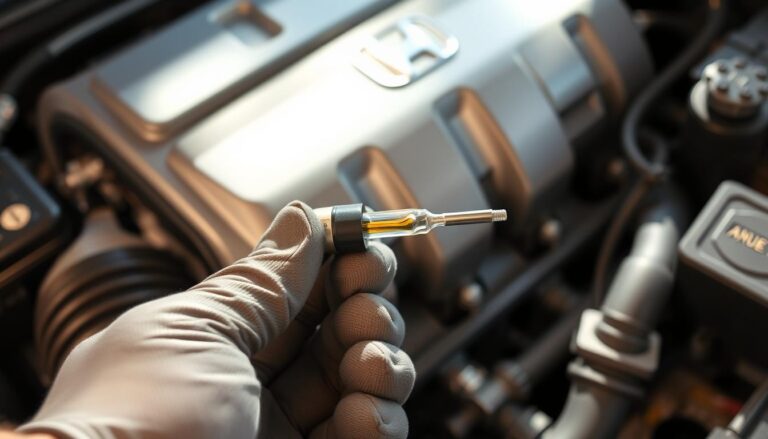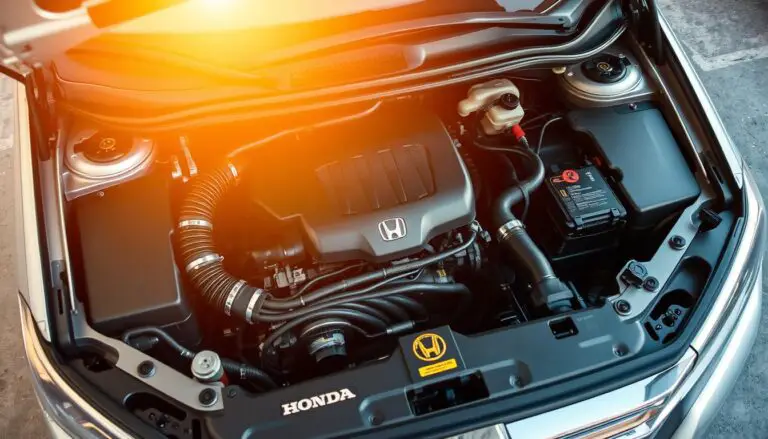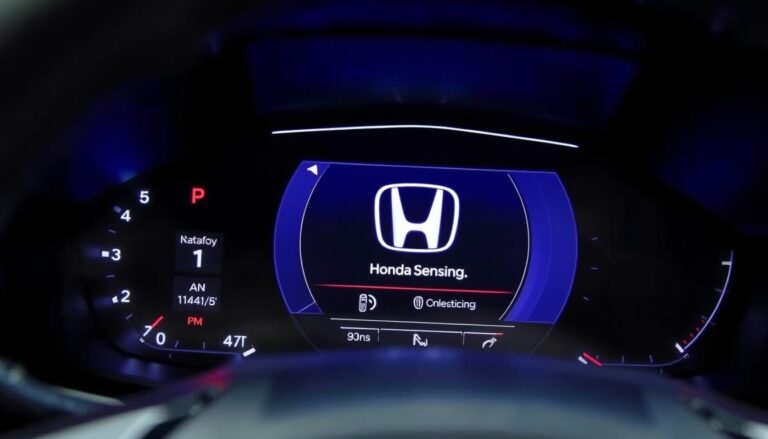The Honda CR-V is a reliable and popular SUV, but understanding its maintenance codes can be confusing. One such code is the B1 service code, which is displayed on the dashboard. This code indicates that a specific maintenance task is required to keep the vehicle running smoothly.
When it comes to Honda CRV maintenance, it’s essential to understand what the B1 code means and what actions to take. This article will provide an overview of the B1 service code, its significance, and the recommended Honda CR-V maintenance schedule.
Key Takeaways
- Understanding the B1 service code and its significance
- Overview of the recommended Honda CR-V maintenance schedule
- Actions to take when the B1 code is displayed
- Importance of regular maintenance for the Honda CR-V
- Tips for keeping your Honda CR-V running smoothly
What Does B1 Mean on Honda CRV?
The B1 service code is an integral part of Honda’s Maintenance Minder System, designed to optimize your CR-V’s performance and longevity. This system is a sophisticated vehicle maintenance management program that alerts drivers to the need for specific services based on the vehicle’s condition and usage.
Honda’s Maintenance Minder System Explained
Honda’s Maintenance Minder System is a cutting-edge technology that monitors your vehicle’s vital signs, including engine oil, transmission fluid, and other critical components. It provides a personalized maintenance schedule based on actual driving conditions, rather than a one-size-fits-all approach. This ensures that your CR-V receives the necessary care at the right time, potentially extending its lifespan and maintaining its performance.
https://www.youtube.com/watch?v=2NjsOdXI_RY
For instance, the system takes into account factors such as driving habits, road conditions, and climate to determine when maintenance is required. This data-driven approach helps prevent unnecessary maintenance, reducing costs and minimizing the environmental impact of unnecessary repairs.
Specific Definition of the B1 Service Code
The B1 service code specifically indicates that your Honda CR-V is due for an oil change and a multi-point inspection. According to YourMechanic, the B1 service typically includes an oil change, tire rotation, and inspection of various vehicle components. The exact mileage at which the B1 service is due can vary depending on the model year of your CR-V and your driving conditions.
| Service Code | Description |
|---|---|
| B1 | Oil change and multi-point inspection |
It’s essential to address the B1 service code promptly to maintain your vehicle’s health and prevent potential issues down the road.
When and Why the B1 Code Appears
The B1 service code is a vital indicator of your Honda CR-V’s maintenance needs, triggered by a combination of mileage, time, and vehicle condition. This code is part of Honda’s Maintenance Minder System, a sophisticated onboard computer that tracks your vehicle’s service requirements.
Mileage and Time Intervals Triggering B1 Service
The B1 service code typically appears based on the vehicle’s mileage and time since the last service. For most Honda CR-V models, this service is required every 7,500 miles or every 12 months, whichever comes first. However, the exact interval can vary depending on the model year and driving conditions.
For instance, driving in severe conditions, such as frequent stop-and-go traffic, extreme temperatures, or towing a trailer, may necessitate more frequent B1 service. The vehicle’s onboard computer takes these factors into account when determining the optimal service schedule.
Variations Across Different CR-V Generations (2007-Present)
The B1 service code and its triggers have evolved across different Honda CR-V generations. While the fundamental principle remains the same, variations exist in the specific service intervals and conditions that trigger the B1 code.
| CR-V Generation | Model Years | B1 Service Interval |
|---|---|---|
| Third Generation | 2007-2011 | Every 7,500 miles or 12 months |
| Fourth Generation | 2012-2016 | Every 7,500 miles or 12 months |
| Fifth Generation | 2017-Present | Every 5,000-7,500 miles or 12 months |
How the Vehicle Monitoring System Determines Service Needs
The Honda CR-V’s vehicle monitoring system uses a complex algorithm to determine when service is needed. This system considers factors such as mileage, engine runtime, and driving conditions to assess the vehicle’s maintenance requirements.

The system provides a percentage of remaining engine life, allowing owners to plan for maintenance accordingly. By understanding how this system works, Honda CR-V owners can better appreciate the importance of the B1 service code and adhere to the recommended maintenance schedule.
Complete Breakdown of B1 Maintenance Requirements
When your Honda CR-V displays the B1 maintenance code, it’s signaling that your vehicle is due for a series of important maintenance tasks. The B1 maintenance requirement is a comprehensive service that includes several key tasks to keep your Honda CR-V running smoothly.

Oil and Filter Change Specifications
One of the primary tasks included in the B1 maintenance is an oil and filter change. Honda recommends using high-quality synthetic oil that meets the API Certification Mark and is of the correct viscosity for your CR-V’s engine. For most models, 0W-20 is the recommended viscosity. The oil filter should also be replaced with a genuine Honda oil filter or an equivalent.
“Regular oil changes are crucial for the longevity of your engine,” as stated in the Honda CR-V owner’s manual. It’s essential to dispose of the used oil and filter responsibly.
Tire Rotation and Inspection Details
The B1 maintenance also includes tire rotation to ensure even wear and extend the life of your tires. Honda recommends rotating the tires every 7,500 miles or at the interval indicated by the maintenance minder. During the rotation, inspect the tires for signs of wear, damage, or uneven wear patterns.
- Check tire pressure monthly and before long trips.
- Inspect tread depth and look for signs of uneven wear.
- Rotate tires according to the pattern recommended by Honda.
Fluid Level Checks and Brake Inspection
In addition to oil changes and tire rotations, the B1 maintenance includes checks of other essential fluids. These include engine coolant, transmission fluid, and brake fluid. It’s also crucial to inspect the brake pads and rotors for wear. Worn brake pads can lead to reduced stopping power and increased risk of accidents.
It’s vital to address any issues with the brakes promptly. If you notice any unusual noises, vibrations, or changes in braking performance, have your vehicle inspected by a professional.
Additional Inspection Points and Safety Checks
During the B1 maintenance, several other inspection points are checked to ensure your vehicle’s safety and performance. These include the condition of the belts and hoses, the battery, and various other components that are critical to your vehicle’s operation.
By following the B1 maintenance requirements, you can help ensure your Honda CR-V remains in good condition, maintains its performance, and provides safe transportation for you and your passengers.
Addressing the B1 Maintenance Code
Understanding how to address the B1 maintenance code is crucial for maintaining your Honda CR-V’s performance and longevity. When this code appears, it indicates that your vehicle is due for a specific maintenance service.
Step-by-Step Reset Procedure for Different CR-V Models
Resetting the B1 maintenance code involves a series of steps that may vary slightly depending on the model year of your Honda CR-V. Generally, you can reset the code by following these steps:
- Turn the ignition switch to the “ON” position.
- Press the “SELECT/RESET” button until the engine oil life appears on the display.
- Press and hold the “SELECT/RESET” button for more than 10 seconds until the oil life resets.
- Turn off the ignition.
For specific models, it’s recommended to consult the owner’s manual or contact a Honda dealership for precise instructions.
Average Costs for Professional B1 Service
The cost of a professional B1 service can vary based on several factors, including the model year of your CR-V, the service provider, and your location. On average, you can expect to pay between $200 to $400 for a complete B1 service, which typically includes an oil change, tire rotation, and other inspections.
- Oil change: $50-$100
- Tire rotation: $20-$50
- Additional inspections: $50-$100
It’s essential to get a detailed quote from your service provider to understand the total cost involved.
Consequences of Ignoring the B1 Maintenance Code
Ignoring the B1 maintenance code can lead to several negative consequences, including reduced vehicle performance, decreased fuel efficiency, and potentially causing more severe damage to your engine or other components over time. Regular maintenance is crucial for extending the life of your vehicle and preventing costly repairs.
Potential risks of neglecting the B1 code include:
- Engine damage due to neglected oil changes
- Uneven tire wear from skipped tire rotations
- Overlooking critical safety inspections
DIY vs. Professional Service for B1 Maintenance
Understanding whether to tackle B1 maintenance on your Honda CR-V yourself or seek professional assistance is key to proper vehicle care. The decision hinges on several factors, including your mechanical aptitude, the tools at your disposal, and the specific requirements of the B1 service.
Tools and Skills Required for DIY Maintenance
To perform DIY B1 maintenance, you’ll need a set of basic tools, including a socket wrench, oil drain pan, new oil filter, and enough motor oil to fill your CR-V. Additionally, having a tire pressure gauge and knowledge of how to rotate your tires is necessary. Familiarity with basic car maintenance procedures is also crucial.
Essential Tools:
- Socket wrench
- Oil drain pan
- New oil filter
- Motor oil
- Tire pressure gauge
Parts and Materials Needed for Complete B1 Service
The B1 service primarily involves an oil and filter change, tire rotation, and various inspections. Thus, the parts and materials needed include high-quality motor oil, a new oil filter compatible with your CR-V’s engine, and potentially other items depending on the findings of the inspection, such as brake pads or fluids.
| Parts/Materials | Description |
|---|---|
| Motor Oil | High-quality oil compatible with your CR-V’s engine |
| Oil Filter | New filter designed for your Honda CR-V model |
| Tire Rotation | Service to ensure even tread wear |
When to Seek Professional Honda Service
If you’re unsure about your ability to perform the B1 maintenance or if your vehicle requires additional repairs beyond the standard B1 service, it’s advisable to seek professional Honda service. Professionals have the necessary experience and equipment to efficiently complete the service and identify any potential issues early on.
Ultimately, the decision between DIY and professional service for B1 maintenance on your Honda CR-V should be based on your comfort level with DIY projects, the complexity of the required service, and your vehicle’s specific needs.
Conclusion
Understanding the B1 maintenance code on your Honda CR-V is crucial for the longevity and performance of your vehicle. As discussed, the B1 code is part of Honda’s Maintenance Minder System, which alerts drivers to necessary maintenance tasks.
A Honda CR-V maintenance summary highlights the importance of regular services, including oil and filter changes, tire rotations, and fluid level checks. The B1 code importance cannot be overstated, as ignoring it may lead to decreased vehicle performance and potentially cause more severe issues.
By addressing the B1 maintenance code promptly and following the recommended maintenance schedule, you can ensure your Honda CR-V continues to run smoothly and safely. Whether you choose to perform DIY maintenance or seek professional service, staying on top of your vehicle’s needs is essential.
FAQ
What does the B1 maintenance code on my Honda CR-V indicate?
The B1 maintenance code signifies that your vehicle is due for a specific maintenance service, which includes an oil change, filter replacement, and other inspections as outlined by Honda’s Maintenance Minder System.
How often does the B1 service code appear on my Honda CR-V?
The frequency of the B1 service code depends on various factors, including mileage and time intervals, as well as the specific generation of your CR-V. Typically, it appears every 5,000 to 7,500 miles or every 6 months, but this can vary.
Can I reset the B1 maintenance code myself?
Yes, you can reset the B1 maintenance code yourself by following a step-by-step procedure specific to your CR-V model. However, it’s recommended to consult your owner’s manual or a professional mechanic to ensure it’s done correctly.
What are the consequences of ignoring the B1 maintenance code?
Ignoring the B1 maintenance code can lead to decreased vehicle performance, reduced fuel efficiency, and potentially cause more severe problems, such as engine damage, if neglected over time.
Is it necessary to visit a Honda dealership for B1 maintenance service?
While it’s not strictly necessary to visit a Honda dealership, it’s recommended to have a professional mechanic, preferably with Honda experience, perform the B1 maintenance service to ensure it’s done according to Honda’s specifications.
What are the average costs for a professional B1 service?
The average cost for a professional B1 service can vary depending on location, labor rates, and the specific services required. On average, you can expect to pay between 0 to 0 for a complete B1 service.
Can I perform the B1 maintenance service myself?
Yes, you can perform the B1 maintenance service yourself if you have the necessary tools, skills, and follow the correct procedures. However, it’s essential to consult your owner’s manual and ensure you’re using the correct parts and materials.


